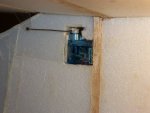quorneng
Master member
Big plane - small servos
On my light weight versions of the 40" Wing Dragon I ended up using cheap and cheerful 3.7g micro servos.
Many forum contributors advised strongly against this saying they were weak, unreliable and would fail after a short time.
To me the advantage of these tiny light servos is that they can be installed close to the control surface allowing a light and efficient linkage.
I have had much bigger servos strip their nylon gears but after analysing what had happened it was clear that it was the sudden retardation resulting from in the crash that had caused the mass of the long (metal) servo to horn link to overload the servo.
I decide to build a bigger plane using the Depron pod & boom pusher layout I had developed from the Wing Dragon but retaining the same 3.7g micro servos.
The wing is made from 3mm Depron with balsa flanges to the spar.

The skin is 2mm Depron.
The 3.7g aileron servo is almost 'lost' in the wing.

60" one piece wing weighs 6oz.

The fuselage is made of 6mm Depron with balsa reinforcement. The wing is carried on a tall pylon to give clearance for the 10" pusher prop.

The elevator servo in the fin. There is no rudder but the ailerons have quite a positive differential action.

Completed.

The motor is rated at 220W. With a 3000mAh 3s it weighs 23oz.
How well would such small servos manage?
Almost straight up and down!
This video was made in 2010. It has had several serious crashes and rebuilds since then yet it still flies with the 3 original 3.7g servos!
I am sure small light efficient linkages and hinges is the answer.
On my light weight versions of the 40" Wing Dragon I ended up using cheap and cheerful 3.7g micro servos.
Many forum contributors advised strongly against this saying they were weak, unreliable and would fail after a short time.
To me the advantage of these tiny light servos is that they can be installed close to the control surface allowing a light and efficient linkage.
I have had much bigger servos strip their nylon gears but after analysing what had happened it was clear that it was the sudden retardation resulting from in the crash that had caused the mass of the long (metal) servo to horn link to overload the servo.
I decide to build a bigger plane using the Depron pod & boom pusher layout I had developed from the Wing Dragon but retaining the same 3.7g micro servos.
The wing is made from 3mm Depron with balsa flanges to the spar.
The skin is 2mm Depron.
The 3.7g aileron servo is almost 'lost' in the wing.

60" one piece wing weighs 6oz.

The fuselage is made of 6mm Depron with balsa reinforcement. The wing is carried on a tall pylon to give clearance for the 10" pusher prop.

The elevator servo in the fin. There is no rudder but the ailerons have quite a positive differential action.

Completed.

The motor is rated at 220W. With a 3000mAh 3s it weighs 23oz.
How well would such small servos manage?
Almost straight up and down!
This video was made in 2010. It has had several serious crashes and rebuilds since then yet it still flies with the 3 original 3.7g servos!
I am sure small light efficient linkages and hinges is the answer.
Last edited:







